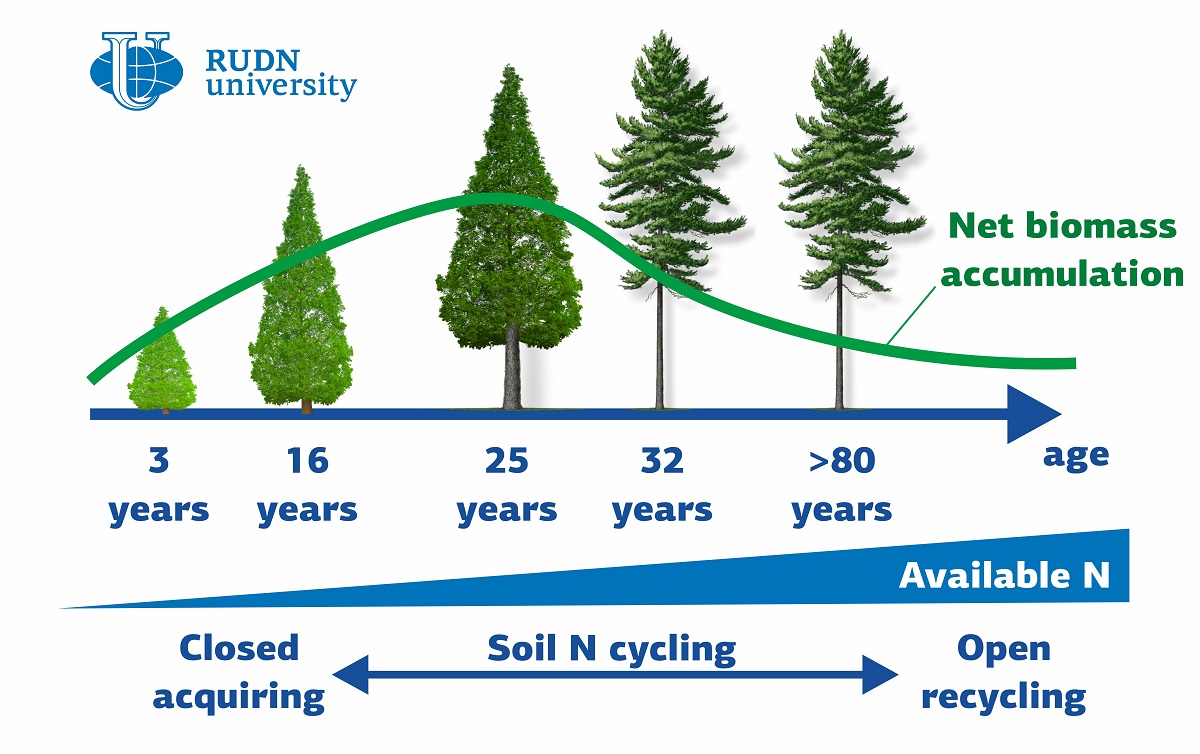The soil scientist of RUDN learned how plantations of coniferous trees keep balance nitrogen in the soil

Forest plantations help mitigate the effects of global warming by absorbing carbon dioxide. However, forests are mostly not fertilized, so the lack of nutrients, including nitrogen, causes low productivity of forest plantations. Cunninghamia Cunninghamia lanceolata is a coniferous tree of the cypress family, grows in China, Vietnam and Laos and is valued for its soft and durable wood. A soil scientist from the RUDN studied the nitrogen cycle on Cunningamia plantations and found out that these ecosystems are able to independently regulate the nitrogen cycle and create favorable conditions for their growth.
“The lack of nitrogen in the soil often limits the productivity of forests, especially on plantations. In order to study the dynamics of nitrogen in the soil and the consequences of its accumulation or loss in the ecosystem, we studied the soils of cunningamia plantations of different ages,” — said Yakov Kuzyakov, Doctor of Biological Sciences, Head of the Center for Mathematical Modeling and and Design of Sustainable Ecosystems of RUDN Agrarian and Technological Institute.
Soil scientists took soil samples from plantations in Hunan Province in southeastern China. The age of the plantations is 3, 16, 25, 32 and more than 80 years, samples were taken at a depth of 0-5 cm and 5-15 cm. The researchers measured the total nitrogen content in the soil and separately in subsystems — in organic matter, in microbial biomass, as well as in nitrates and ammonium. Soil scientists have calculated how much nitrogen trees accumulate per year, how much they dump with foliage, as well as how much nitrogen microorganisms release from fallen parts of plants.
The biggest difference in these parameters was observed in the upper soil layer. The total content of the element and its amount in dissolved organic form increased from three- to eighty-year-old samples from 3.5 to 6.5 g/kg. The nitrogen content in microbial biomass increased from 206 mg/kg to 327 mg/kg in the first 25 years, and then the level stabilized. The amount of ammonium increased sharply from the 3rd to the 16th year of plantation life from 10 to 30 mg per kg, and the amount of nitrates gradually increased during all 80 years from 5 to 60 mg per kg.
Soil scientists have found out that nitrogen deficiency or, conversely, its active return to the soil depends on the age of the plantations. Young seedlings absorb the element they need for growth, while more fallen needles and branches are formed from “adult” trees, which “return” nitrogen. Mature trees are not moving up so fast, they consume nitrogen more slowly, so it accumulates in the upper layers of the soil. This makes the element accessible to the microbial community.
“With the age of plantations, the availability of nitrogen in the soil increases, and the nitrogen cycle in the ecosystem accelerates. This means that there is a self-regulation mechanism in the ecosystem, thanks to which cunningamias gradually create more comfortable conditions for growth and development,” — added Yakov Kuzyakov.
The article was published in the journal Forest Ecology and Management.
The project to develop a cellular model of the placenta became the winner in the Scientific Materials category of the Young Scientists 3.0 competition, organized with the support of the Presidential Grants Foundation and T-Bank.
Ten scientific journals published by RUDN University have been included in the highest level of the state list of scientific publications, the White List.
Forests are not only the lungs of the planet, but also home to millions of species. However, it has remained unclear how underground interactions between trees and fungi affect forest species richness in different climatic conditions. Previous studies have yielded conflicting results: in some regions, the dominance of certain fungi reduced tree diversity, while in others it increased it.
The project to develop a cellular model of the placenta became the winner in the Scientific Materials category of the Young Scientists 3.0 competition, organized with the support of the Presidential Grants Foundation and T-Bank.
Ten scientific journals published by RUDN University have been included in the highest level of the state list of scientific publications, the White List.
Forests are not only the lungs of the planet, but also home to millions of species. However, it has remained unclear how underground interactions between trees and fungi affect forest species richness in different climatic conditions. Previous studies have yielded conflicting results: in some regions, the dominance of certain fungi reduced tree diversity, while in others it increased it.